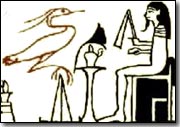| |
|||||||
|
|||||||
HELIOPOLIS -- IUNU -- ON |
|||||||
 |
|
||||||
Creation was viewed as an evolutionary process. However, it was recorded in typical Egyptian metaphors of birth rather than in scientific or philosophical terminology. Grain was stored in Heliopolis for the winter months, when many people
would descend on the town to be fed, leading to it gaining the additional
title "Place of Bread". The Book of the Dead goes
further and describes how Heliopolis was the place of multiplying bread,
recounting a myth in which Horus feeds the masses there with only 7
loaves. |
|||||||
Egyptians believed Heliopolis was the location of the Ben-Ben, the pyramid-shaped stone which was the first mound to arise from the primordial "Waters of Potentiality" at the moment of creation. On the Ben-Ben the Raas a Bennu - the white heron called Phoenix by the Greeks - first sang the song of creation. The bennu-bird figured prominently in paintings and reliefs throughout Egyptian history. The obelisk (above), the sacred symbol of the sun-god, gave
the city its Egyptian name. Obelisks were topped by a pyramid--shaped
sacred capstone (representing the Ben-Ben stone). Examples of such capstones
have been found. They were coated in electrum (gold and silver foil),
in order to catch and gleam with the rays of the sun. Numerous obelisks
in open-air courts decorated the city. Most have been taken over the
centuries. |
 |
||||||
Little is known about the city itself. The remains of mud-brick walls in the area suggest a vast enclosure estimated at 3,600 by 1,558 feet, and recent excavations have found signs of what may be a number of separate temples or parts of one great temple of New Kingdom date. Its principal feature was a temple devoted to Tem and Ra, the precise shape and location of which is uncertain. Today the only standing monument is a large red granite obelisk (above), dedicated by Senusret I and dating back only to the 12th Dynasty. Earlier structures include the Third Dynasty fragmentary shrine of Djoser.These fragments show scenes connected with the celebration of a Sed-festival and/or with the Ennead worshipped there. Other structures also included part of a 6th Dynasty obelisk of Teti. Several Old Kingdom tombs of high priests dating to the 6th Dynasty have been found southeast of Senusret’s obelisk, near the southeast corner of the enclosure. A stela of Tuthmosis III from the 18th Dynasty commemorates a wall that encloses the solar temple. Excavations have revealed some Ramesside construction – several temples and a cemetery for the Mnevis bulls discovered northeast of the obelisk and dated to the 19th - 20th Dynasties. The bulls were worshipped as manifestations of the sun-god.
|
|||||||
 |
|
||||||
Near the entrance to the base of the obelisk was a small chapel, with two basins on both sides of its door and two granite stelae. The walls of the chamber were decorated with reliefs showing foundation-ceremonial and feasts in the temple. Donation lists from the time of Ramesses III indicate that the Temple of Ra at Heliopolis were second only to those of Amun at Thebes. After the end of the New Kingdom, the fortunes of Heliopolis began to decline. The city was largely destroyed during the Persian invasion of 525 and 343 BC, although enough of its structures and reputation remained to attract tourists in Greco-Roman times. The Temple of Ra held a special place as a depository for royal records, and Herodotus states that the priests of Heliopolis were the best informed in history and astronomy of all the Egyptians. The schools of philosophy and astronomy are claimed to have been frequented by Plato, Solon, Pythagoras, and other Greek philosophers. When Strabo visited the site in the late first century BC, he found it partly abandoned (although some priests still lived there) and by the first century AD, most of the statuary and obelisks had been removed to Alexandria and Rome. The remaining structures then served as a quarry for the building of medieval Cairo.
|
|||||||
Home | Nile Valley | Dynasties | Wealth | Divinity | Temples | Hieroglyphs | Mysteries
|
|||||||